Love is in the air! This "LOVE-ly" gorgeous quilt was made with vintage Valentine handkerchiefs by my quilt customer, Shawn T. She always has wonderful, creative ideas, and this was no exception!
She wanted the edges of the quilt to mimic a handkerchief itself! Scallops are so beautiful, and if you prepare the quilt and use the following tips and tricks, it's totally doable.
MARK. I used a curved ruler and marked the corners, then divided the remaining space between the corner scallops into thirds, traced my curved ruler and marked the quilt with my Frixion removable marking pen. I left the edges square so I could mount the quilt to the longarm frame.
BASTE. I basted a scant 1/4-inch inside the drawn lines, also allowing for some space as I quilted, so the binding would not cover up any of the quilting design.
TRIM. Once quilted, the edges needed to be trimmed smoothly so that the binding will also look smooth; long strokes with sharp shears. It also helped to stitch a squiggly line of basting to manage the edges.
MAKE BIAS BINDING. << see Tutorials, Any curved edge will need to use binding that is cut from fabric at a 45-degree angle. Bias binding can stretch to suit scallops and curved edges. I use 2-inch strips and sew to the quilt with a 1/4-inch seam allowance. Any wider than two inches and I have trouble with my edges buckling and not lying smooth. Join bias strips with a diagonal seam, trim, and press seams open. This will reduce the bulk so the binding is not lumpy. Press binding lengthwise in half.
NOTE: I always fold my binding into a Figure 8 around my thumb and forefinger. Then, when I pull it from the center, it never twists up. See this
video. Try it!
APPLY BINDING. Leave about an 8" tail, then align the raw edges of the binding with the raw edges of the quilt. I began near a corner so I could have about 8 inches of space to make the final seam. I use my 1/4" quilter's presser foot (#57 on my Bernina), which also has a metal guide bar on the side to help control the width of the seam.
1) Sew slowly and carefully, easing the binding under the needle at each stitch for a little extra "give" around any outside curves. A stiletto, large pin, or the point of a seam ripper will help, and remember to keep the raw edges aligned. Keep the needle in the down position when you stop to adjust.
I also like to put a vinyl glove on my left hand to help grip the quilt. This somehow alleviates the tension I get in my fingers, hand, wrist, elbow, shoulder and back! It works wonders!
2) At each inner point, clip to, but not through the basting line of stitches. This step is vital! Then add a long pin at the same angle of the cut so you will know where to stop sewing and adjust the quilt.
3) Stitch to the pin, then remove the pin and take one more stitch.
4) With the needle still down, raise the presser foot and FOLD to pivot the quilt and straighten out your stitching path! Best trick ever! This works because the inner seam was clipped. Lower the foot, then keep sewing straight along the curve, easing the binding in as before. When you release the quilt, the binding will form a natural inner miter.
FINAL SPLICED SEAM. By the way, this is how I finish all my bindings, curved or straight, faux-piped or super wide. The technique is the same, and works for any width of binding, just adjust the seam allowance wider if the binding is wider.
Stitch the binding all the way around the quilt. When you get past the final inner point, stop about 8 inches from your beginning stitches. This gap is where you will operate to sew the final diagonal seam. All you will need is:
* a scrap of binding to use as your measuring tool
* a couple of pins or clips
* a small pair of sharp scissors that can clip to the tip
1) Overlap the binding tail end over the beginning tail. Open up the binding scrap you trimmed off and slip between the tails, centered between the beginning and ending stitches.
2) Make a 1/8-inch clip through all four layers of binding, on the left side of the scrap.
3) Trim off the ending tail exactly where that little clip was made. I like to fold over the binding strip at the clip, and slide my scissors in to make the cut. And breathe. That side is done!
4) Now move the ending tail out of the way, and, with the binding scrap (measuring tool) still in position next to the little clip on the left, make another little snip on the right side of the scrap.
4) Trim off the beginning tail exactly at your 2nd clip. This step adds the width of binding to the beginning tail so that we have exactly enough fabric to overlap and sew a diagonal seam.
5) Next, get ready to sew the ends together. I always say this to myself:
"RIGHT SIDE, RIGHT SIDE; LEFT SIDE, WRONG SIDE."
The right tail, or ending tail should be unfolded and flattened, with the right side of the fabric facing up. The quilt is in front of you, and the binding is pulled toward you, so that the corner is pointing at your belly button.
The left tail, or beginning tail, should be opened up with the wrong side up. This is probably a bad diagram since I am using a solid dyed fabric and you can't really see that the left side is actually wrong side up... but trust me!
Then, I fold the left side UP as pictured, matching the point to the little clip, and I press a crease to get my stitching line! Genius! Say it again:
"Right side - right side up, Left side, wrong side up", then fold up the corner.
6) Pinch and clip the quilt so the binding ends can overlap outside of the quilt. Position the left binding tail perpendicular to the right tail with right sides together, and pin in place.
7) Stitch the seam. The folded line is the stitching line. Hint: This final spliced seam will always be sewn parallel to the edge of the quilt - the same direction as if you were sewing it to the quilt!
8) Clip your threads and test to make sure you have not twisted your binding, then trim the seam and press it open.
9) Re-fold the binding in half, line it up, then stitch it to the quilt, overlapping the beginning and ending stitches.
10) Finger-press and fold the binding to the back of the quilt, making sure it is filled with batting and covers up the stitches on the other side. Hand-stitch to the quilt using thread that matches the binding. OR, machine-stitch-in-the-ditch like I do on most of my quilts these days.
I use the Edge-Joining foot with a guide down the middle (#10 on my Bernina), which glides along my "ditch". The needle follows the guide, catching the binding on the back. Match the bobbin thread to the binding and the top thread to the quilt top.
For some reason, I have no close-up picture of the back of the binding, but it looks lovely, believe me.
I'll be off to teach my ever-popular "Binding & Alternate Endings" class at a retreat this week - I'd love to show this quilt for a sample, too bad I had to ship this quilt back to its owner! But it has inspired me! I need to check out vintage Valentine handkerchiefs and make a quilt like this for myself! Love, love, love it! ♥♥♥
Happy Valentine's Day!




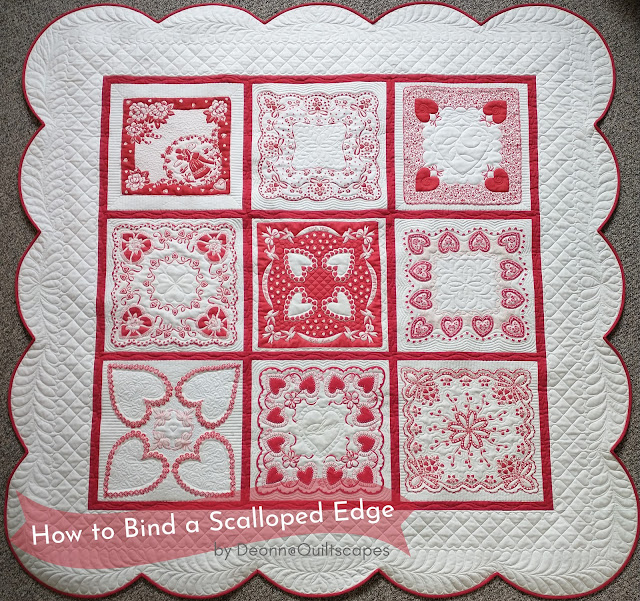
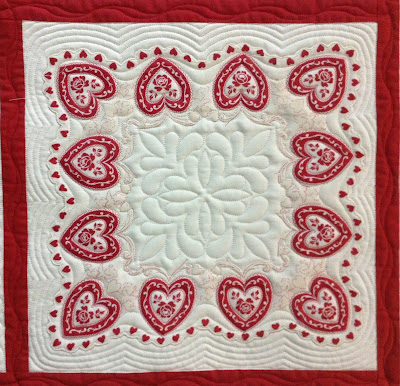









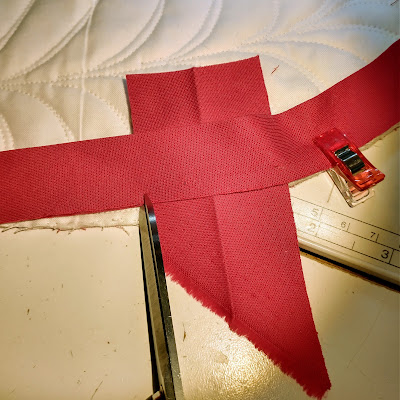


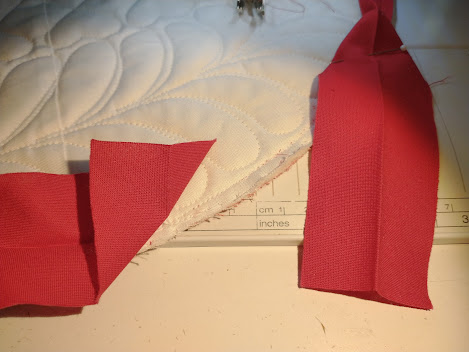


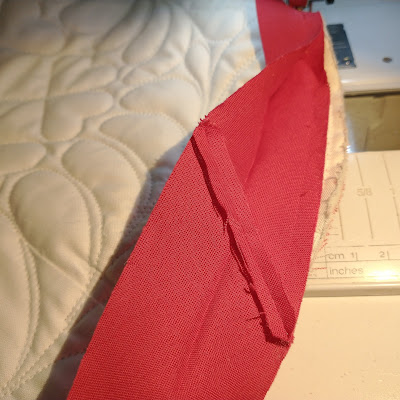





Thank you so much! Your tutorial is a gift from heaven! I have a double wedding ring quilt made by one of my husband’s family members that has their family tree embroidered in the middle. I do not know how old it is but was hand pieced with no batting. I was asked to see if I could do something to extend its life. I had planned to quilt it to batting and backing but was in a quandary as to how to bind it as the edges are scalloped. Now I know exactly what to do. Thank you, thank you!
ReplyDeleteWhat a gorgeous quilt with such beautiful quilting and lovely tutorial for special scallops! Thank you!!
ReplyDeleteThis is he perfect border for that gorgeous quilt. Thank you for the tutorial.
ReplyDeleteI love that beautiful quilt. Thanks for the detailed tutorial.
ReplyDeleteSo beautiful!
ReplyDelete